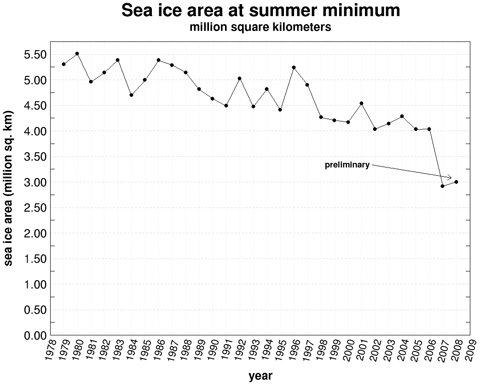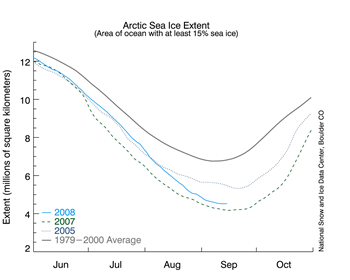Although “This year was cooler and other weather conditions weren’t as bad” as last year, the Arctic sea-ice minimum came within 150,000 square miles of last year’s record decline.
This is clear evidence that last year was no fluke and that human-caused global warming has become a major — if not the dominant — driver of long-term Arctic sea ice decline, which in turn could rapidly accelerate the destruction of a livable climate.
The National Snow and Ice Data Center reported yesterday that the 2007 minimum was probably reached Friday, when “sea ice extent dropped to 4.52 million square kilometers (1.74 million square miles),” which is “the second-lowest recorded since 1979, and is 2.24 million square kilometers (0.86 million square miles) below the 1979 to 2000 average minimum.”

The NYT’s Andy Revkin has a nice figure from the University of Illinois (above) and notes on his blog:
Yesterday, several ice experts, including William Chapman of the University of Illinois, Marika Holland at the National Center for Atmospheric Research, and Walt Meier at the Boulder ice center, said that cloudier weather had prevented early-summer heating and that the strong winds that opened big stretches of water last year were not repeated this summer.
Nonetheless, Revkin titles his post “Arctic Ice Retreat Misses Last Year’s Mark” [rather than throwing in a “barely” or a “just” or a “despite cooler weather”] and he still says weakly:
Global warming from the buildup of human-generated greenhouse gases almost certainly contributes to the Arctic ice retreats, according to a host of Arctic specialists.
Andy, you’re killing me (and the planet): The best you can do is “almost certainly contributes“? C’mon already. The word “contributes” could mean, like, a 1 percent contribution, dude! At the very least, couldn’t you at least drop the “almost certainly”? Even better, just say, “is almost certainly a major contributor” — especially since you are attributing that not to “the overwhelming majority of climate scientists” as I think it is warranted, but merely “a host of Arctic specialists.” I will say “a host of” beats your usual formulation of “many.”
The NSIDC adds “A word of caution on calling the minimum”:
Determining with certainty when the minimum has occurred is difficult until the melt season has decisively ended. For example, in 2005, the time series began to level out in early September, prompting speculation that we had reached the minimum. However, the sea ice contracted later in the season, again reducing sea ice extent and causing a further drop in the absolute minimum.
We mention this now because the natural variability of the climate system has frequently been known to trick human efforts at forecasting the future. It is still possible that ice extent could fall again, slightly, because of either further melting or a contraction in the area of the pack due to the motion of the ice. However, we have now seen five days of gains in extent. Because of the variability of sea ice at this time of year, the National Snow and Ice Data Center determines the minimum using a five-day running mean value.
The bottom line as far as the Arctic is concerned, according to the NSIDC’s Walt Meier:
We’re kind of in a new state of the Arctic basically, and it’s not a good one. We’re definitely sliding towards a point where the summer sea ice will be gone.
And that is very bad news for the rest of us, since it is likely to accelerate the melting of the tundra and hence the emission of massive quantities of carbon from the permafrost, which would in turn make catastrophic global warming far more difficult to prevent.
This post was created for ClimateProgress.org, a project of the Center for American Progress Action Fund.


